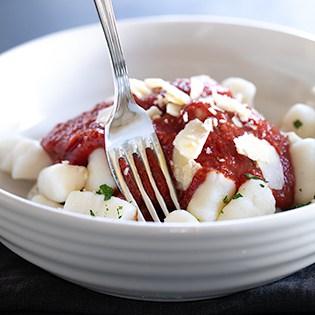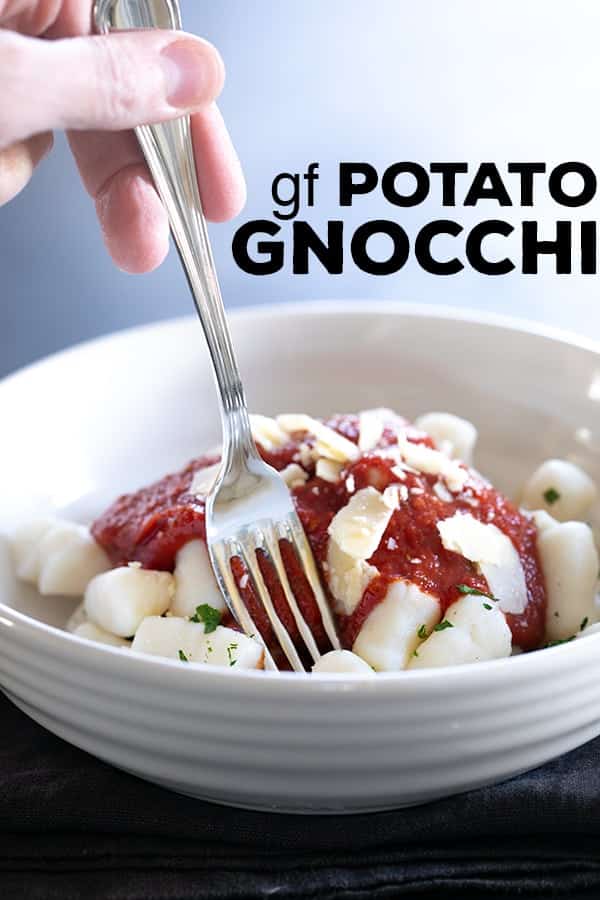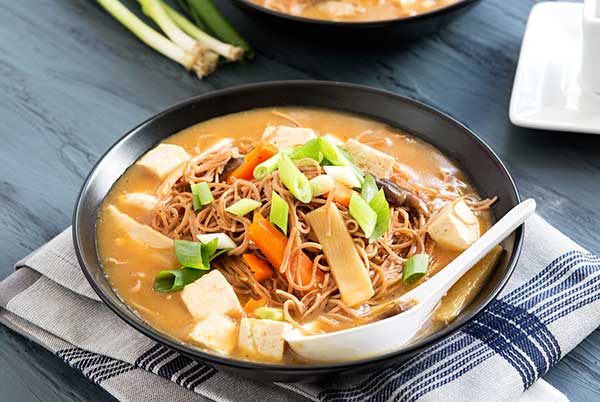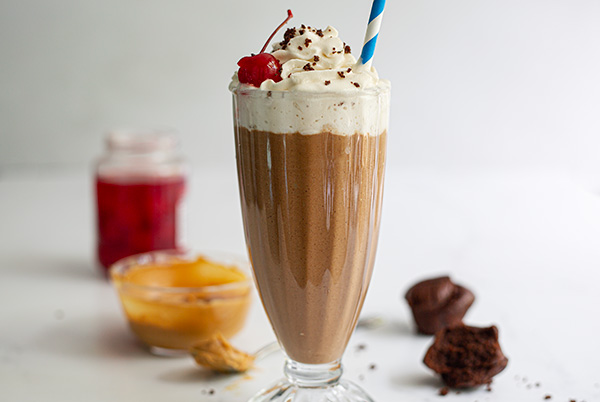This recipe for gluten free potato gnocchi makes the soft, pillowy and tender mini dumplings you remember. Freeze them, shaped, and boil them in minutes straight from the freezer!

Soft, tender, and delicate dumplings, gluten free gnocchi make for a hearty meal with your favorite sauce. Learn how to prepare your potatoes in the perfect way to make quick work of this authentic dish!
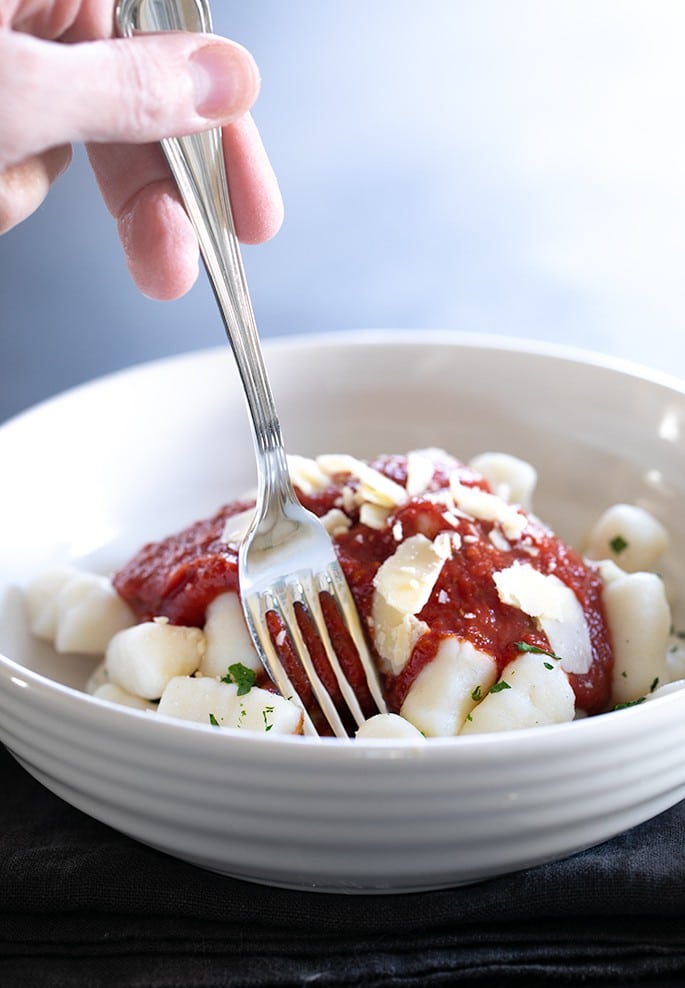
What makes this the best gluten free gnocchi?
Many recipes for gnocchi call for preparing the potatoes by boiling them until fork tender, like we did when we steamed them in our post about how potatoes are gluten free. That’s just silly to me. Steamed potatoes absorb way too much water, and require us to rebalance the moisture in the mixture to make proper dumplings.
Baking the potatoes in a dry, hot oven just until they’re soft will dry them sufficiently. That means that you’ll need to add less flour to the mashed potatoes and your gnocchi will light and flavorful. Be sure you bake them until they’re truly soft inside, though, or you won’t be able to mash them properly and the dough will be very hard to shape without its falling apart.
Once they’re baked, allow them to cool just until you can handle them comfortably. Then, use a vegetable peeler or sharp knife to remove the skin plus any harder outer layer that formed during baking.
When potatoes are boiled properly, the skin should nearly just fall off the potato. It will be a little more challenging to remove the skins from a baked potato, but the end result of tender and flavorful potato gnocchi makes it all worthwhile, and a hearty gluten free dinner is served!
How to make gluten free gnocchi
Making good gnocchi begins with properly preparing the potatoes. Once they’re prepared and processed, all that’s left is to add melted butter, salt, and flour, shape the dumplings and then boil them.
- Bake the potatoes. Bake russet potatoes in their skins until they give to gentle but firm pressure when you squeeze them. Allow them to cool until you’re able to handle them, then peel off the skins.
- Mash the potatoes. I like to use a potato ricer to mash the potatoes since that is the fastest way to create an even, smooth mash without any lumps. But a fork will do. Add the melted and cooled butter and salt. Be careful not to overwork the potatoes or they’ll soften too much. Chill the mashed potatoes so the starches have a chance to resolidify. That’s how we know they’ll hold their shape as dumplings.
- Add the gluten free flour. This is the part that takes your properly mashed potatoes and makes them into gnocchi. Mix in nearly the full cup of gluten free flour (with xanthan gum). The dough should hold together when you knead it with clean hands. If you give it a squeeze and it squishes out of the gaps between your fingers, you either haven’t chilled the potatoes enough, or you haven’t added enough flour.
- Shape the dumplings. Once the dough is the right consistency, shaping is easy. Roll portions of dough into ropes either between your palms held in the air, or on a flat, lightly floured surface by pushing away from yourself. Let the shaped dough sit for a bit to allow the flour to absorb as much moisture as possible so your dough holds its shape during boiling. Cut the ropes into bite-sized pieces and make ridges in each dumpling by pressing it into the back of the tines of a fork. This helps them hold sauce.
- Boil the gnocchi. Boil a large pot of salted water, place the dumplings in the hot water a few at a time, and boil until the dumplings float to the top of the water. Give them a little gentle stir after placing them, in small batches to avoid overcrowding, in the water so they don’t stick to the bottom of the pot.
- Serve. Remove the boiled gnocchi from the water with a fine mesh sieve, cover with sauce, and serve hot.
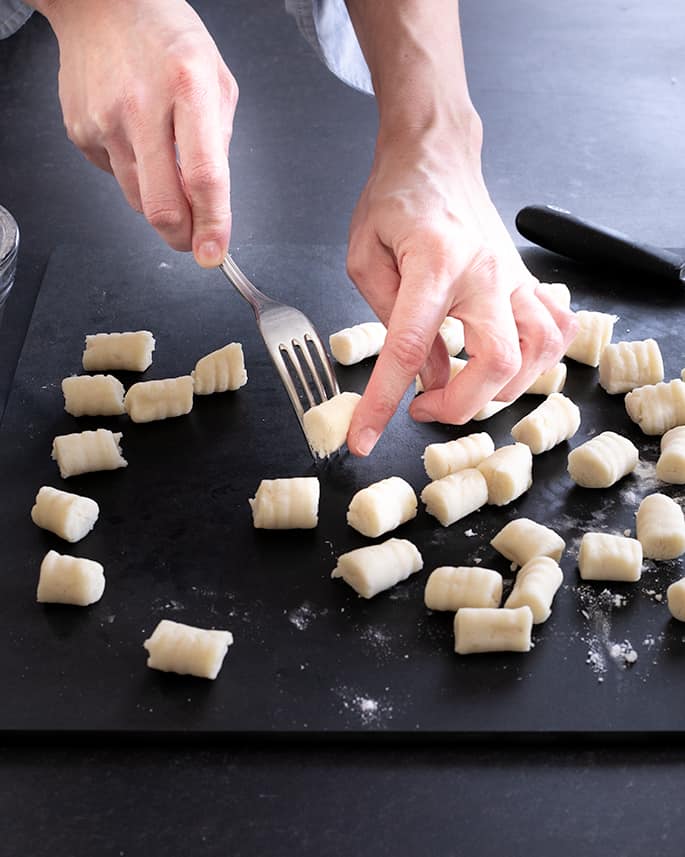
Tips for making perfect gluten free gnocchi
How to mash the potatoes
If you’ve ever made mashed potatoes, you know you want them to be smooth but never sticky or glue-like. You never want to mash potatoes in anything like a blender or food processor, which will heat the potatoes and either liquefy them or turn them into a thick glue.
The best tool for making light and fluffy mashed potatoes is a potato ricer, which looks a bit like a citrus juicer. It forces the cooked potato through small round holes and makes a rice-like product. I have a simple one from Priority Chef brand that I bought online.
I’ve also used a food mill to make mashed potatoes, which is sort of like an old-school, hand crank food processor. If you don’t already have a food mill, though, don’t bother buying one. It takes up way too much space and is awkwardly-shaped, making it difficult to store. Its utility is limited, too.
If you don’t have a potato ricer, a large fork will work just fine. Make sure you don’t leave any hard bits of potato that haven’t been riced or somehow processed. It’s those larger bits of potato that tend to make the dough crumbly.
A sneaky mashed potato shortcut for making gluten free potato gnocchi
So… I make the entire Thanksgiving meal myself from top to bottom, almost entirely from scratch. One October, in anticipation of the Eating Olympic holidays, I decided to try the frozen mashed potatoes from my local Trader Joe’s, in case I needed a little help.
Well, I was thrilled to find out that those little frozen nuggets can be turned into the most perfect mashed potatoes you’ll ever have. I plan to use them for holidays until the end of time, so I was curious to see if I could make those mashed potatoes into potato gnocchi. And it worked!
I recommend using a ratio of 1 1/2 pounds (24 ounces) of defrosted mashed potatoes in place of the 2 pounds of raw potatoes that we use in this recipe. You won’t need the butter or salt, either, since the prepared mashed potatoes already have both in them. Add the flour slowly, and proceed with the recipe as written.
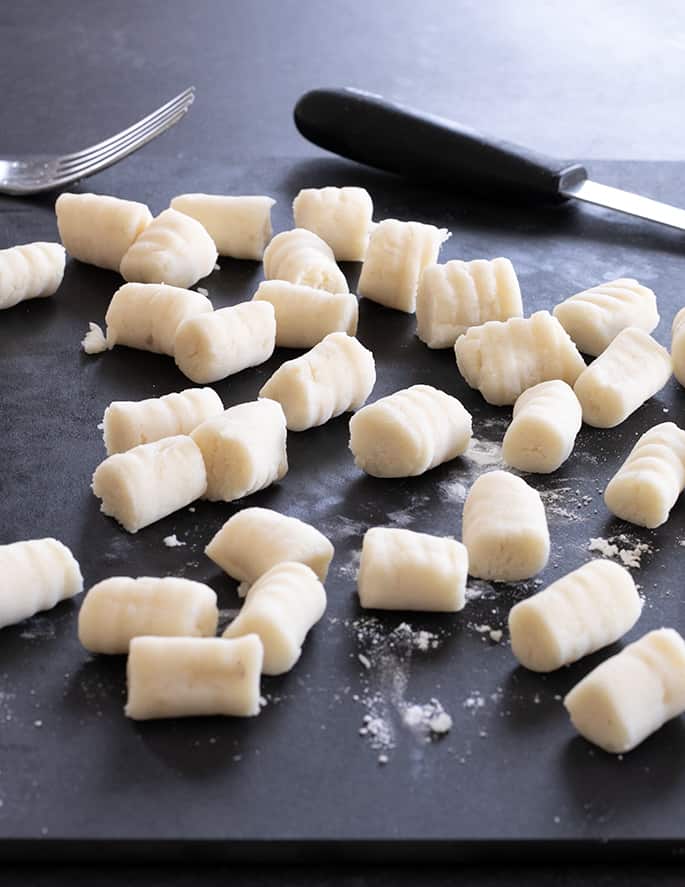
Shaping the perfect gnocchi
Using too much flour in your potato gnocchi dough will make your dumplings tasteless and tough, not tender. Add the flour slowly, since you can always add more, but you can’t remove it once it’s been mixed into the dough.
They say that making really good potato gnocchi takes practice, which I guess it does. But mostly it takes proper technique, which can be learned in theory before you ever put it into practice. That’s where I come in!
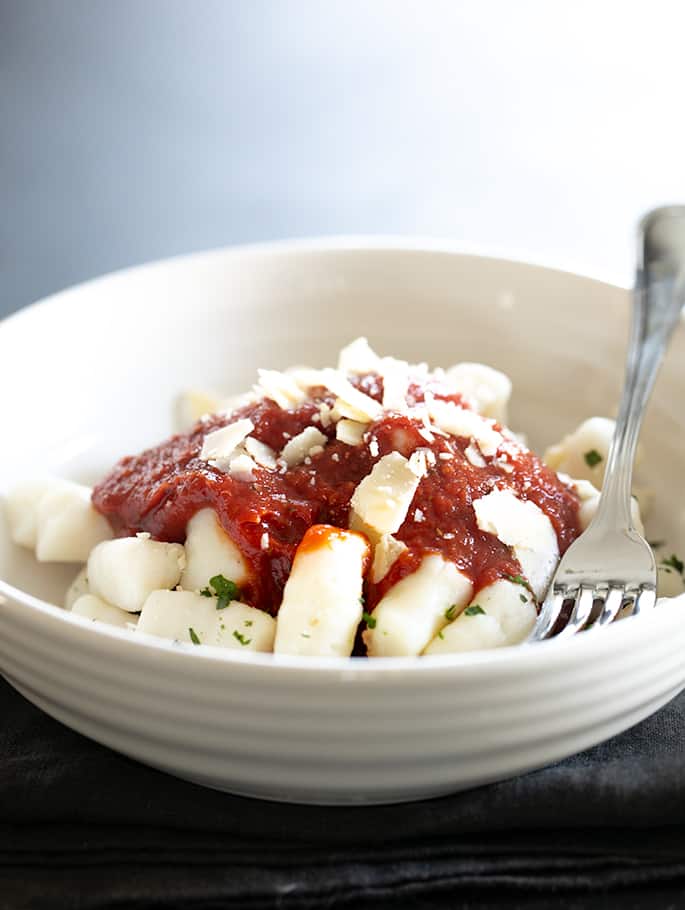
Make your gnocchi in smaller batches
I’ve found that rolling shorter ropes, rather than long, snaking pieces of dough, makes shaping gnocchi much easier to handle. I recommend working with about a handful of dough at a time. If your mashed potatoes are smooth and not lumpy, and you add the flour slowly, you’re going to be successful.
Make sure your gf gnocchi dough has no lumps
If you find that the dough is crumbling as you try to shape it, you can add a drop of water to the dough, or you can try using a large fork to mash the dumpling mixture to ensure that there aren’t any large lumps. It’s mostly the lumps that will make the dough crumble.
Avoid any gaps in your gf gnocchi dough
I recommend squeezing the dough periodically as you roll it, to ensure that there aren’t any gaps in the dough. It should be solid all the way through. Otherwise, the dumplings won’t hold together when you cut them from the ropes.
Shape the gf dumplings with the tines of a fork
If you plan to make gnocchi often (have you tried my recipe for zucchini ricotta gnocchi?), you may want to buy a gnocchi board. It’s just a small rectangular piece of wood with ridges that are made to create the proper ridges in your dumplings. It’s those ridges that help the dumplings hold onto whatever sauce you serve them with.
I don’t own a gnocchi board. Although my family loves these little dumplings, I only make them every couple of months. I simply use the back of the tines of a large dinner fork to create the proper ridges. It’s a little more difficult to create prominent ridges, but it does the job.
You can also create ridges by pressing down on both sides of each dumpling with the tines of the fork as the dumplings lay flat on the counter. But that compresses the dumplings into flatter pillows, which isn’t the shape we want.
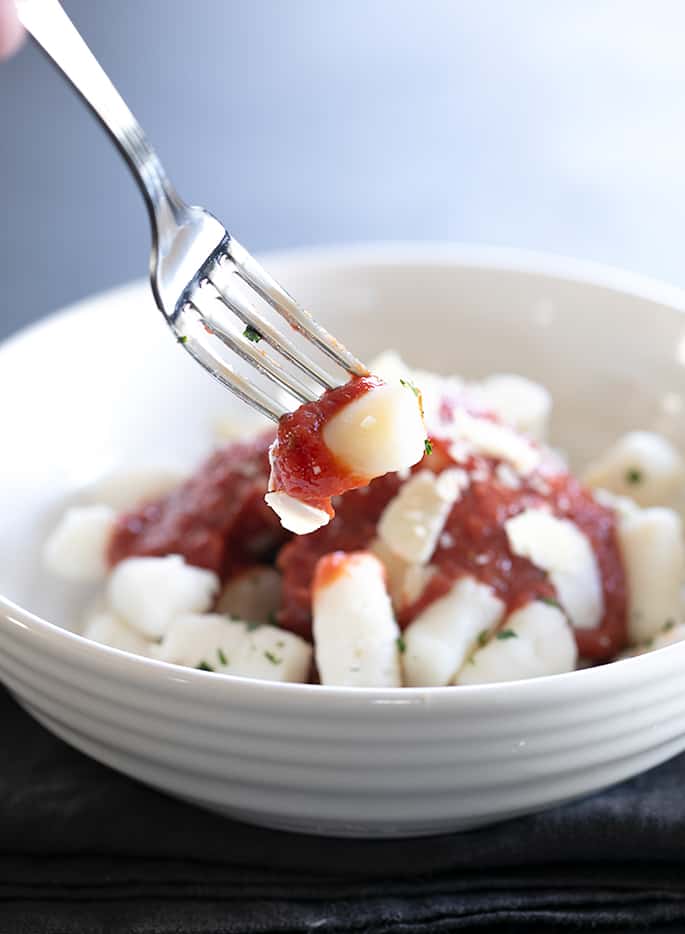
Gluten free potato gnocchi: ingredients and substitution suggestions
Potato gnocchi are made with very few ingredients (really just mashed potatoes and flour), so there aren’t too many possible substitutions to discuss.
Gluten free dairy free potato gnocchi
In place of butter, try using virgin coconut oil or Earth Balance buttery sticks. If you use Earth Balance, omit the salt in the recipe as it’s already very salty. It has more moisture than butter, as well, so you may need to add a bit more flour to the dough.
Russet potatoes
Instead of russet, you can use Yukon gold potatoes. I would avoid using waxier potatoes like red skin as the dumplings will become gooey when boiled.
Gluten free egg free potato gnocchi
This recipe for potato gnocchi is made without eggs, which is traditional. But the truth is that adding an egg white to the dough will make it easier to handle.
If you plan to double the recipe, I recommend adding an egg white. Just expect to add a bit more flour to rebalance the dough.
FAQs
No, traditional gnocchi is not gluten free. It’s made with potatoes and conventional flour, which contains gluten. This gnocchi is made with gluten free flour, so it’s safe for anyone on a gluten-free diet.
Did you bake the potatoes you used in your gnocchi, instead of boiling them? Did you knead together the gnocchi dough until firm before shaping it? Were your potatoes lumpy? Lumpy potatoes will prevent your dumplings from holding together properly.
I like to use a potato ricer to process the baked and skinned potatoes so there are never any lumps. Make sure that your potatoes are baked all the way through, too, before attempting to process them. Any slightly raw parts will stay lumpy no matter what you do.
When gnocchi are finished boiling, they will float to the top of the pot of boiling water. Stir the water gently to ensure that no dumplings are sticking to the bottom of the pot, too, so they have a chance to boil on all sides and float to the top to let you know that they’re ready to eat!
Gluten Free Gnocchi | Soft Potato Dumplings
This recipe for gluten free potato gnocchi makes the soft, pillowy and tender mini dumplings you remember. Freeze them, shaped, and boil them in minutes straight from the freezer!
Yield: 4 servings
Prevent your screen from going dark
Ingredients
- 4 large (2 pounds) russet potatoes
- 2 tablespoons (28 g) unsalted butter melted and cooled
- ½ teaspoon kosher salt
- 1 cup (140 g) all purpose gluten free flour blend plus more as necessary (I used Better Batter; click thru for details)
- ½ teaspoon xanthan gum omit if your blend already contains it
- Tomato sauce for serving (optional)
- Shredded cheese for serving (optional)
Instructions
Prepare the potatoes.
-
Preheat your oven to 400°F. Wash, pierce and bake the potatoes in their skins for 45 minutes to 1 hour, or until they give when you squeeze them.
-
Let the potatoes cool slightly, then peel them. I use a vegetable peeler but a carefully wielded sharp knife will do.
-
Mash the peeled, cooked potatoes. If you have a potato ricer or food mill, use it to mash the potatoes until smooth. Otherwise, mash with a fork until as smooth as possible.
Prepare the gnocchi dough.
-
Place the mashed potatoes in a large bowl, add the butter and salt, and mix to combine. Cover the bowl and place the mashed potatoes in the refrigerator to chill until no longer warm (about 20 minutes).
-
Remove the potatoes from the refrigerator, uncover the bowl, and add almost all the flour and xanthan gum, reserving a few tablespoons.
-
Mix with a spoon and then switch to kneading the dough together with clean hands. It should hold together well when squeezed and feel firm but not dry.
-
If the dough seems too soft, add more flour by the teaspoonful and knead it in. You can always add more flour, but you can’t remove it so proceed carefully.
Shape the gnocchi.
-
Pull off pieces of dough about a handful at a time and place on a very lightly floured flat surface.
-
Squeeze the dough firmly between your palms and then roll either between your palms or with your palms on the flat surface, pushing away from your body.
-
Squeeze together any cracks in the dough with your fingers and roll into a cylinder. After you have rolled a few ropes, let them sit undisturbed for a few minutes to give the dough a chance to absorb the moisture of the potatoes.
Cook the gnocchi.
-
While the dough is sitting, bring a large pot of water to a rolling boil over medium-high heat.
-
Once the water has boiled, cut the ropes into approximately 1-inch pieces with a sharp knife, and then mark each with the back of the tines of a large fork to make ridges.
-
In batches of about 20, gently drop the dumplings into the boiling water and allow the gnocchi to cook for about 3 minutes, or until they all float to the top.
-
Remove the cooked gnocchi with a slotted spoon and place on serving dishes. Repeat with the remaining dumplings.
-
Serve immediately with tomato sauce, grated or shaved cheese, and fresh herbs, if you like.
Make ahead ideas.
-
The raw, shaped individual dumplings can be frozen in a single layer on a baking sheet, then sealed in an airtight container for later use.
-
Boil them from frozen, simply adding a minute or two to the boiling time.
Gluten Free Gnocchi | Soft Potato Dumplings
This recipe for gluten free potato gnocchi makes the soft, pillowy and tender mini dumplings you remember. Freeze them, shaped, and boil them in minutes straight from the freezer!
Yield: 4 servings
Prevent your screen from going dark
Ingredients
- 4 large (2 pounds) russet potatoes
- 2 tablespoons (28 g) unsalted butter melted and cooled
- ½ teaspoon kosher salt
- 1 cup (140 g) all purpose gluten free flour blend plus more as necessary (I used Better Batter; click thru for details)
- ½ teaspoon xanthan gum omit if your blend already contains it
- Tomato sauce for serving (optional)
- Shredded cheese for serving (optional)
Instructions
Prepare the potatoes.
-
Preheat your oven to 400°F. Wash, pierce and bake the potatoes in their skins for 45 minutes to 1 hour, or until they give when you squeeze them.
-
Let the potatoes cool slightly, then peel them. I use a vegetable peeler but a carefully wielded sharp knife will do.
-
Mash the peeled, cooked potatoes. If you have a potato ricer or food mill, use it to mash the potatoes until smooth. Otherwise, mash with a fork until as smooth as possible.
Prepare the gnocchi dough.
-
Place the mashed potatoes in a large bowl, add the butter and salt, and mix to combine. Cover the bowl and place the mashed potatoes in the refrigerator to chill until no longer warm (about 20 minutes).
-
Remove the potatoes from the refrigerator, uncover the bowl, and add almost all the flour and xanthan gum, reserving a few tablespoons.
-
Mix with a spoon and then switch to kneading the dough together with clean hands. It should hold together well when squeezed and feel firm but not dry.
-
If the dough seems too soft, add more flour by the teaspoonful and knead it in. You can always add more flour, but you can’t remove it so proceed carefully.
Shape the gnocchi.
-
Pull off pieces of dough about a handful at a time and place on a very lightly floured flat surface.
-
Squeeze the dough firmly between your palms and then roll either between your palms or with your palms on the flat surface, pushing away from your body.
-
Squeeze together any cracks in the dough with your fingers and roll into a cylinder. After you have rolled a few ropes, let them sit undisturbed for a few minutes to give the dough a chance to absorb the moisture of the potatoes.
Cook the gnocchi.
-
While the dough is sitting, bring a large pot of water to a rolling boil over medium-high heat.
-
Once the water has boiled, cut the ropes into approximately 1-inch pieces with a sharp knife, and then mark each with the back of the tines of a large fork to make ridges.
-
In batches of about 20, gently drop the dumplings into the boiling water and allow the gnocchi to cook for about 3 minutes, or until they all float to the top.
-
Remove the cooked gnocchi with a slotted spoon and place on serving dishes. Repeat with the remaining dumplings.
-
Serve immediately with tomato sauce, grated or shaved cheese, and fresh herbs, if you like.
Make ahead ideas.
-
The raw, shaped individual dumplings can be frozen in a single layer on a baking sheet, then sealed in an airtight container for later use.
-
Boil them from frozen, simply adding a minute or two to the boiling time.
